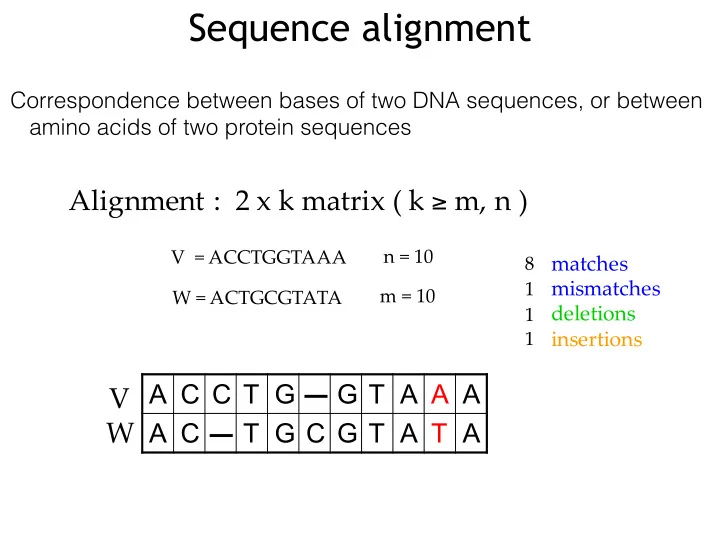

Sequence alignment Correspondence between bases of two DNA sequences, or between amino acids of two protein sequences Alignment":""2"x"k"matrix"("k" ≥ m,"n") n"="10 V""="ACCTGGTAAA matches 8 mismatches 1 m"="10 W"="ACTGCGTATA deletions 1 insertions 1 V A C C T G G T A A A W" A C T G C G T A T A
“Goodness” of alignments Given two sequences, there are many possible alignments ATTTTCCC distance=2 ATTTACGC ATTT-TCCC distance=3 ATTTA-CGC ATTTTCCC———————— distance=16 ————————ATTTACGC Edit distance : the total number of substitutions, insertions and deletions needed to transform one sequence to another
Manhattan tourist problem Imagine seeking a Source * * path (from source to sink) to travel * (only eastward and * * southward) with the * most number of * * attractions (*) in * the Manhattan grid * * * Sink
Recursive algorithm -> Dynamic programming Function MT ( n,m ) 1. x = MT(n-1,m)+ weight of the edge from (n-1,m) to (n,m) 2. y = MT(n,m-1)+ weight of the edge from (n,m-1) to (n,m) 3. return max{x,y} MT (x, y) returns the “most weighted” path from point (x, y) to the “sink”.
How to find the optimal path 0 1 2 3 source 1 2 5 0 1 3 8 • Start from Sink. i 5 3 10 $5 • Find which of the two $5 1 $5 1 5 4 13 8 edges gave the “max”. Take it. 3 5 $3 2 3 3 $5 2 • Repeat. 8 9 12 15 0 0 $5 1 0 0 0 3 8 9 9 16 S 3,3$ =/16
Recipe 1. Identify subproblems 2. Write down recursions 3. Make it dynamic-programming!
The edit distance problem A F G C D E Match A G Insertion_X C Insertion_Y D E F A-GCDEF AFGCDE-
Minimum Edit Distance For sequence X and Y
Optimal alignment match match
Complexity
Is the edit distance the best way? For sequence X and Y
Amino acids can share similar properties
Weighted edit distance • To generalize scoring for DNA/RNA, consider a 4x4 scoring matrix S . • In the case of an amino acid sequence alignment, the scoring matrix would be a 20x20 size. • The addition of d is to include the score for comparison of a gap character “-”. • Two questions: • (a) What should S be? • (b) How do we find optimal scoring alignment?
Weighted edit distance • To generalize scoring for DNA/RNA, consider a (4+1) x(4+1) scoring matrix S . • In the case of an amino acid sequence alignment, the scoring matrix would be a (20+1)x(20+1) size. • The addition of d is to include the score for comparison of a gap character “-”. • Two questions: • (a) What should S be? • (b) How do we find optimal scoring alignment? Traditionally, people tend to maximize the alignment score with a negative gap penalty score
BLOcks SUbstitution Matrix (BLOSUM) amino acids
BLOcks SUbstitution Matrix (BLOSUM)
Recursion for generalized edit distance Complexity?
Gap score/penalty
Affine gap penalty Question: How to develop an efficient dynamic programming algorithm for affine gap penalties?
Categories of pairwise alignments
Semi-global alignment
Semi-global alignment
Local alignment: naive algorithm • Long run time O(n 4 ): - In the grid of size n x n there are n 2 vertices (i,j) that may serve as a source. - For each such vertex computing alignments from (i,j) to (i’,j’) takes O(n 2 ) time. • This can be remedied by allowing every point to be the starting point
Local alignment: Smith-Waterman algorithm Idea: start over from any entry!
Local alignment
Recommend
More recommend